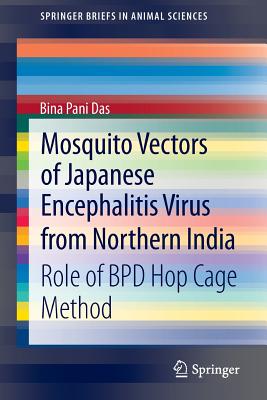
Mosquito Vectors of Japanese Encephalitis Virus from Northern India: Role of Bpd Hop Cage Method (Springerbriefs in Animal Sciences)
Description
Japanese encephalitis and problem in vector surveillance: An Introduction.-1.1 Introduction.- 1.2 Global Scenario .- 1.3 Emergence of JE in India .-1.4 Magnitude of JE problem in India.- 1.4.1 Trend of JE occurrence.-1.4.2 Contribution of JE cases by states .- 1.4.3 Concept of endemic and epidemic districts in India .-1.5 JE outbreaks in India .-1.6 Clinical presentation and diagnosis.-1.6.1 Laboratory diagnosis.-1.7 Epidemiology of Japanese encephalitis.- 1.7.1 Natural History .- 1.7.2 Seasonality.-1.8 Vectors of Japanese encephalitis .- 1.9 Problem faced while investigating AES/JE outbreak in Northern India .- 1.10 Research problem addressed by the author and included in this book .-1.10.1 Developed a new sampling technique for JE vector Surveillance.-1.10.2 Pictorial key to common species of Culex (Culex) mosquitoes associated with Japanese encephalitis virus in India.- 1.10.3 Ecological studies on JE vectors in Northern India .-1.10.4 Discovery of a new Bio-control agent .-1.10.5 Situation specific vector control measures.-1.11 JE Control Programme in India.- 1.11.1 Vaccination.- 1.11.2 JE Vector control .- References.- 2 Mosquito surveillance tools used and methodology followed in Ecological study on JE vectors in Northern India .- 2.1 Introduction.-1.2 Study area.- 2.2.1 Phase 1: Non-endemic area: In and around Delhi (1998-2002).- 2.2.2 Phase 2: Endemic area I: Karnal District, Haryana state of India (2002-2004) .-2.2.3 Phase 3: JE endemic area II: Saharanpur district, Uttar Pradesh state of India (2005-2006) .- 2.3 Methodology.- 2.3.1 Metrological data.- 2.3.2 Epidemiological data .-2.3.3 Sampling of adult mosquitoes.- 2.3.4 Sampling mosquito larvae.-2.3.5 Mosquito blood meal identification.- 2.3.6 JE virus detection.- 2.4 Pictorial key for identification of common species of Culex (Culex) mosquitoes.- References.-3 Pictorial key to common species of Culex (Culex) mosquitoes associated with Japanese encephalitis virus in India.-3.1 Introduction.- 3.2 Pictorial ey.- References.- 4. BPD hop cage method for effective JE vector surveillance.-4.1 Introduction.- 4.2 Standardization of BPD hop cage method for sampling JE vectors.- 4.3 Identification of natural day resting places of Cx. tritaeniorhynchus in and around Delhi.- 4.4 Comparative efficacy of drop net, hand catch and BPD hop cage method for monitoring JE vector abundance.- 4.5 Use of BPD hop cage method in JE vector surveillance and outbreak investigation of Japanese Encephalitis .- 4.5.1 JE vector surveillance.-4.5.2 Outbreak investigation of AES/JE.- References.- 5 Ecology of Culex tritaeniorhynchus Giles in and adjoining areas of Delhi, non-endemic area in northern India, with special reference to Chilodonella uncinata as a bio-control agent .-5.1 Introduction .- 5.2 Seasonal abundance of Culex tritaeniorhynchus in and around Delhi .- 5.3 Resting preference of Culex tritaeniorhynchus in and around Delhi .- 5.4 First time detection of overwintering phenomenon in Culex tritaeniorhynchus in India.- 5.5 Breeding habit of Culex tritaeniorhynchus in and around Delhi.- 5.6 Natural microbial organisms found infecting JE vector larvae in and around Delhi .- 5.6.1 Discovery of a new microbial control agent for mosquito vectors of human Diseases.- 5.6.2 Events that lead to the invention .- 5.6.3 Problems encountered in detection, isolation and identification of the causative organism.-5.6.4 Biological characteristics of Chilodonella uncinata .- 5.6.5 Role of Ch. uncinata on the population dynamics of Cx. tritaeniorhynchus mosquito in nature.- 5.6.6 Colonization of Ch. uncinata under laboratory condition: .- 5.6.7 Formulation.- 5.6.8 Mode of entry of Ch. uncinata inside the host body and su.
